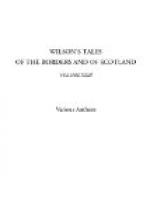The parties were now face to face in court, and the battle behoved to be fought out; but as in all legal cases, where the circumstances are strange or peculiar, the story soon gets wind, so here the Meggat’s Land romance was by-and-by all over the city. Nor did it take less fantastic forms than usual, where sympathies and antipathies are strong in proportion to the paucity of the facts on which they are fed. It was a favourite opinion of some, that the case could only be cleared by supposing that a dead stranger child had been surreptitiously passed off, and even coffined, as the true one; while others, equally skilled in the art of divining, maintained that the child given to Mrs. Hislop by Cowie was a bastard of his own, by the terrible woman Isabel Napier, who was thus, according to the ordinary working of public prejudice, raised to a height of crime sufficient to justify the hatred of the people: on which presumption, it behoved to be assumed that the paper containing the curse was a forgery by Cowie and his associate in crime, and that the money paid to Mrs. Hislop was furnished by the lady; all which suppositions, and others not less incredible, were greedily accepted, for the very reason that it required something prodigious to explain an enigma which exhausted the ordinary sources of man’s ingenuity; just as we find in many religions, where miracles—the more absurd, the more acceptable—are resorted to to explain the mystery of man’s relation to God, a secret which no natural light can illuminate.
But all these suppositions were destined to undergo refractions through the medium of a new fact. The case, by technical processes, came before the Court of Session, where the diversity of opinion was, proportionably to the number of judges, as great as among the quidnuncs outside. The only clear idea in the heads of the robed and wigged wiseacres was, that the case, Napier versus Napier, was a puzzle which no man could read or solve. It seemed fated to be as famous as the old Sphinx, the insoluble Moenander, or the tortuous labyrinth, or the intricate key of Hercules—ne Apollo quidem intelligat; and if it had not happened that Lord Kames suggested the possibility of getting an additional piece of evidence through the examination of the coffin wherein Mrs. Napier was buried, the court might have been sitting over the famous case even in this year of the nineteenth century. The notion was worthy of his lordship’s ingenuity; and accordingly a commission was issued to one of the Faculty to proceed to the West Church burying-ground, and there cause to be laid open and examined the coffin of the said Mrs. Henrietta Preston or Napier, with the view to ascertain whether or not the body of a child had been placed therein along with the corpse of the mother.




